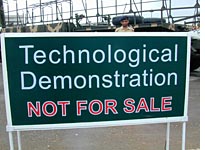http://scisec.net/?p=214
What I would like you to focus on is something else. Look at AQ Khan. Actually, look at what he is holding. He is holding a soccer ball (football; I don't know how Americans can get away calling NFL "football").
Why a football?
As the ACW explains
...AQ Khan graces the cover, holding a soccer ball (which is basically the size and configuration of the shell of high explosives in a nuclear weapon), standing in front of a blackboard showing a nuclear weapon diagram. The most shocking detail is the notation “Uran Deuteride Initiator.”...
Wiki has a good little discussion on this
...The Fat Man bomb had two concentric, spherical shells of high explosives, each about 10 inches (25 cm) thick. The inner shell drove the implosion. The outer shell consisted of a soccer-ball pattern of 32 high explosive lenses, each of which converted the convex wave from its detonator into a concave wave matching the contour of the outer surface of the inner shell. If these 32 lenses could be replaced with only two, the high explosive sphere could become an ellipsoid (prolate spheroid) with a much smaller diameter...
There might be a bit of a contradiction in all these leaks about Iranian weaponisation.
I am referring to two-point implosion. Global security.org has a good little primer on two-point linear implosion. The football reference here is to what Americans call a "football".
...The two ends of a cylinder, or an ovoid, could be driven toward each other to create a high-density sphere. This two-point detonation greatly reduced the diameter and the weight of the primary.
A linear implosion allows for a low density, elongated non-spherical (football shaped) mass to be compressed into a supercritical configuration without using symmetric implosion designs. This assembly is accomplished by embedding an elliptical shaped mass in a cylinder of explosive. The explosive is detonated on both ends, and an inert wave shaping device is required in front of the detonation points. Extensive experimentation was needed to create a workable form, but this design enables the use of Plutonium as well as Uranium...
For two-point spherical implosion, which is actually more relevant, see the link to Wiki above.
It has been alleged that Iran has a two-point implosion based weaponisation programme.
The Guardian had a good story on Iran and two-point implosion
...The UN's nuclear watchdog has asked Iran to explain evidence suggesting that Iranian scientists have experimented with an advanced nuclear warhead design, the Guardian has learned.The very existence of the technology, known as a "two-point implosion" device, is officially secret in both the US and Britain, but according to previously unpublished documentation in a dossier compiled by the International Atomic Energy Agency (IAEA), Iranian scientists may have tested high-explosive components of the design. The development was today described by nuclear experts as "breathtaking" and has added urgency to the effort to find a diplomatic solution to the Iranian nuclear crisis...
...Documentation referring to experiments testing a two-point detonation design are part of the evidence of nuclear weaponisation gathered by the IAEA and presented to Iran for its response...
The Guardian also notes
...The first implosion devices, like the "Fat Man" bomb dropped on Nagasaki on 9 August 1945, used 32 high-explosive hexagons and pentagons arrayed around a plutonium core like the panels of a football. The IAEA has a five-page document describing experimentation on such a hemispherical array of explosives...
If the UD3 story is true, that Iran might have resumed an active weaponisation programme, then the two-point implosion story might be false. This is because this story basically alleges that Iran is working on a nuclear weapon initially designed by the Chinese and handed down to Pakistan which in turn was handed to Iran.
AQ Khan is holding a football/soccer ball (the number of panels in the actual Chinese design is irrelevant).
That's not two-point implosion.
Perhaps Iran has dabbled with both and has given two-point implosion away as being too risky. Perhaps Iran is using a UD3 trigger for its own design based on two-point implosion or perhaps the two-point implosion story is false.
If the latter, then at least one of the documents much discussed in the context of Iranian weaponisation is baloney.
As matters currently stand we are in no position to determine which of these possibilities is correct.


